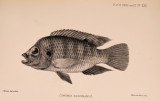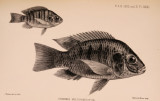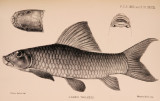| OCR Text |
Show 286 MR. C. TATE REGAN ON [Nov. 4, which it so closely resembles in other skeletal characters, the so-called ribs are epipleurals. In the Plectognathi the post-temporal is more reduced and more intimately connected with the skull than in the Acanthuridae, in which family it is attached by its proximal and distal ends, but separated from the skull by a foramen for most of its length. The co-ossification of the pelvic bones is more complete in these fishes than in the Acanthuridse. Praecaudal and anterior caudal vertebrae, with epipleurals, of Balistes aculeatus. In Dr. Gill's diagnosis of the Plectognathi occur the words: " The elements of the lower jaw consolidated into two pieces representing the rami; " this applies very well to the Sclerodermi, but in the Gymnodontes the suture between dentary and arti-culare is quite evident, and in Mola at any rate these bones can scarcely be described as consolidated. Another character used by Gill to define the Plectognathi is " Interoperculum detached from the other opercular bones, reduced and more or less rod-like in form." I find that in the Sclerodermi this bone is rod-like anteriorly, and posteriorly expanded and attached to the suboperculum, this posterior portion being in some cases, e. g. Triacanthus, strongly ossified, in others, e. g. Ostracion, almost entirely membranous. In the Gymnodontes it is rod-like, but only in the Tetrodontidse is it unconnected posteriorly with the suboperculum. Supraclavicle vertical; pterygials (pectoral basalia) not enlarged, movably attached by ligament to the scapula and coracoid, three to the former and one to the latter. All the vertebra; with the neural arches forming a single spine. Basis cranii more or less distinctly double. Dentary and articulare completely co-ossified. 1 Trachyeephahis De Vis (nec Tsclmdi), described as a Scleroderm in Proc. Linn. Soc. N.S.W. viii. 1883, p. 455, is evidently not a Plectognath. Text-fig. 56. Division I. S c l e r o d e r m i 1. |
































































































































































































































































































































